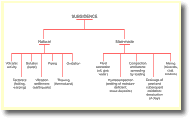
|
|
|||||||||
Subsidence
Subsidence often occurs gradually over many years and may go unnoticed. Indicators of subsidence may be an increase in flood frequency or structural damage to buildings, roads and railways. Precise techniques are required to measure this slow movement and these may include repeated survey levels at precisely locate benchmarks, or by measuring the compaction of deposits using a compaction recorder. The ground surface in a subsidence system is maintained at an equilibrium
level when all the various stresses that are applied to it are in
balance. When one of these stresses increases, or decreases then
this balance is upset and subsidence may occur. These imbalances
may be triggered by imposing a heavy load on the ground surface,
e.g. a reservoir, or lowering fluid pressure in the ground, e.g.
extracting oil or water. The response to varying stress changes
will vary depending on the nature of the materials affected and
the type of changes that occur. Compaction of the soil may also
cause subsidence. Withdrawal of fluids Subsidence is usually associated with the withdrawal of two fluids, (1) oil and (2) water. When the fluid is extracted the fluid pressure in the underground reservoir, or aquifer, is reduced. This then increases the gravitational stress applied by the overlying deposits and the dynamic seepage stress which is caused by the dragging effect of vertically moving interstitial fluids on particles in the system. These affects of stresses are cumulative and lead to a reduction in the ratio between the volume of voids, or spaces, and the volume of solids, and thus to changes in the properties of the deposits and compaction results. This compaction may be permanent or reversible. In deposits of coarse sand and gravel when fluid pressures fall compaction is immediate. However, when fluid pressures are restored expansion follows. Aquifers which react in this way are termed elastic bodies. In non-elastic bodies, e.g. fine clay beds, compaction results in the permanent rearrangement of the sediment structure (Cooke and Doornkamp, p. 171; Costa and Baker 1984, p. 287). In may cases fluid extraction from aquifers in younger Quaternary aged deposits suffer the greatest compaction and subsidence at the surface is pronounced. This may be because in older aquifers the sediments which contain the fluid have already been subjected to compaction and sedimentation and thus experience less consolidation when water is removed. Ground subsidence as a result of extraction of oil and water is
a relatively recent phenomenon, arising largely from the demand
for supplies of oil and rapidly increasing requirement for water,
particularly in large industrial centres and areas of extensive
agricultural irrigation. However, extraction of oil is likely to
lead to greater subsidence. Oil reservoirs are generally deeper
and have lower porosity and permeability than groundwater reservoirs.
Oil reservoirs are also under greater pressure (Cooke and Doornkamp
1974, p. 172). Oil and gas extraction Subsidence as a result of oil extraction was first recognised in
the Texas oilfields. At Goose Creek, Texas, land adjacent to a oil
field subsided 1 m in the 8 years following the start of production
in 1917. At the Wilmington oil field, Long Beach California, subsidence
began in 1937, reached a maximum rate of 07 m/yr in 1951, coinciding
with maximum oil extraction, and maximum subsidence measured 9 m
in the worst affected area in the centre of the filed. Subsidence
occurred close to the coast and dykes and seawalls were constructed
to prevent inundation of the oil field (Costa and Baker 1981, p.208).
Deformation of the oil bearing sediments as a result of the subsidence
caused rupture of wells, and surface tension in the subsiding area
caused rupture or pipelines and buckling of railway lines. Failure
of a man-made reservoir dam is also attributed to the oil extraction
and associated subsidence (Cooke and Doornkamp 1974, p. 174-175).
Sediments beneath the reservoir subsided creating tensional stress
at the surface. This triggered small earthquakes and fault lines
opened up near top the reservoir. These cracks were a route for
water flow into the reservoir and then propagated downstream of
the reservoir dam, undermining it and causing it to fail. Five people
were killed and US$15 million worth of damages were caused by the
ensuing flood. Water withdrawal Mexico City has experienced widespread subsidence as a result of water withdrawal from Quaternary-aged sand and gravel aquifers underlying the city resulting in ground surface subsidence of 7 m between 1880 and 1970. Ground water withdrawal in the city is now highly regulated. The island city of Venice is also subsiding as a result of withdrawal of water from Quaternary-aged sands, silts and clays beneath the city. Although Venice is a residential city two nearby industrial cities of Mestre and Marghera extract large volumes of water. Maximum subsidence between 1952 and 1969 has been measured at 14 cm for Mestre and 11 cm for Venice. The problem for Venice is exacerbated by the fact that lowering of the ground surface has increased the frequency of flooding during high tides (Costa and Baker 1981, p. 289-290). Withdrawal of water in limestone regions may also escalate land
instability in these regions. Lowering of the water table by water
withdrawal allows runoff to greater depth. Ground water dissolves
the limestone and transports overlying material with it creating
underground tunnels and caverns and collapse of the roof of these
features causes subsidence. Irrigation and land drainage Some deposits which comprise unconsolidated, low density material have high strength and are able to withstand large grain-to-grain stresses without compacting. Some examples of materials are loose, dry alluvium and debris flow deposits and dry loess and wind blown deposits. The strength within the deposits is attributed to films of dry clay bonding the grains together, cohesion and/or cementation, e.g. by calcium carbonate. However, when water is applied to these materials they lose this strength and the material compacts casing subsidence, or hydrocompaction. This may occur in arid regions when water is applied for irrigation (Costa and Baker 1981, p. 292; Cooke and Doornkamp 1974, p. 180-183). Clay soils expand when they are wet and if they become dry then
they contract. Organic soils behave in a similar fashion. Removing
water by land drainage from either of these soils will result in
subsidence. In general removal of water from organic soils is conducted
for land reclamation. Problems arise in these situations when gravity
drainage of the soils is no longer possible due to the level of
subsidence. Furthermore as the depth of soil decreases subsurface
drainage methods become impractical, drainage ditches need to be
cut into bedrock and the soil may eventually become economically
unusable. Mining Subsidence resulting from mining is a particular problem in older
coalmining regions where coal was extracted but no corrective measures
used to fill or strengthen the cavities created. The extent and
downward displacement of subsidence depends on the form of mining,
thickness of the coal seams and nature of the overlying strata.
The amount of subsidence that can be expected is about two thirds
of the thickness of coal removed. The effects of subsidence due
to mining are similar to those in areas where oil and water is extracted.
Towns are commonly located near to coalmines and as a result of
rapid expansion in the last 20 years urban development has built
over old mine shafts and workings increasing the burden on the workings.
There are examples of houses being damaged or destroyed when the
mine workings collapse. Case study: Wairakei and Broadlands geothermal fields, New Zealand In many parts of the world geothermal systems, or reservoirs, are exploited for power generation. Some of the simplest methods involve extraction of hot water from these systems which is then piped to houses for heating purposes. More complex methods involve extraction large volumes of gas or steam from the system and using this to generate electricity. In New Zealand, Wairakei and Broadlands geothermal fields are examples of geothermal systems that are being exploited for power production. Wairakei is an example of a liquid-dominated hydrothermal field and hot water and steam are extracted. The geothermal reservoir is confined between underlying impermeable volcanic bedrock and overlying relatively impermeable overlying mudstone. It is believed that the reservoir was filled with water to the base of the mudstone prior to drilling. Exploitation began in 1950 and increased significantly in 1958 when power generation began. The total number of wells drilled in the field was 141 in 1968 when drilling ceased. Between 1958 and 1962 only 10 % of the volume of water extracted recharged into the system. This lead to large pressure drops in the system which then lead to subsidence of the ground surface. However, recharge increased to 90 % in the years following, and the fall in pressure was less dramatic. Subsidence in the region affects an area over 3 km3. Surveyed maximum subsidence of 4.5 m is measured, and associated horizontal ground movements of about 0.5 m are also measured. This surface deformation has disrupted pipelines carrying steam, cracked drainage canals and caused the main road to sink by 2 m. Estimated annual costs of fixing the pipelines and canals is about NZ$260,000. The problems associated with exploitation of the geothermal resources at Wairakei and Broadlands are twofold, (1) withdrawing water and steam from the reservoir reduces pressure within the system, which effectively lowers the power generating capacity of the field, and (2) ground subsidence, which results from this pressure reduction. There is a possibility that ground and surface subsidence may also increase small scale earthquake activity in the region. Remedial measures used to try and combat these problems primarily involve attempts to recharge the geothermal field by either (1) stopping extraction and allowing recharge to occur naturally, or (2) pumping water into the system (reinjection). After the Broadlands field shutin (1971-74) pressures began to build up in the reservoir and ground uplift as opposed to subsidence occurred. Reinjection has also proved successful although it is unlikely to reverse ground subsidence but is intended to minimise the surface effects.
|
|||||||||
|
|||||||||


